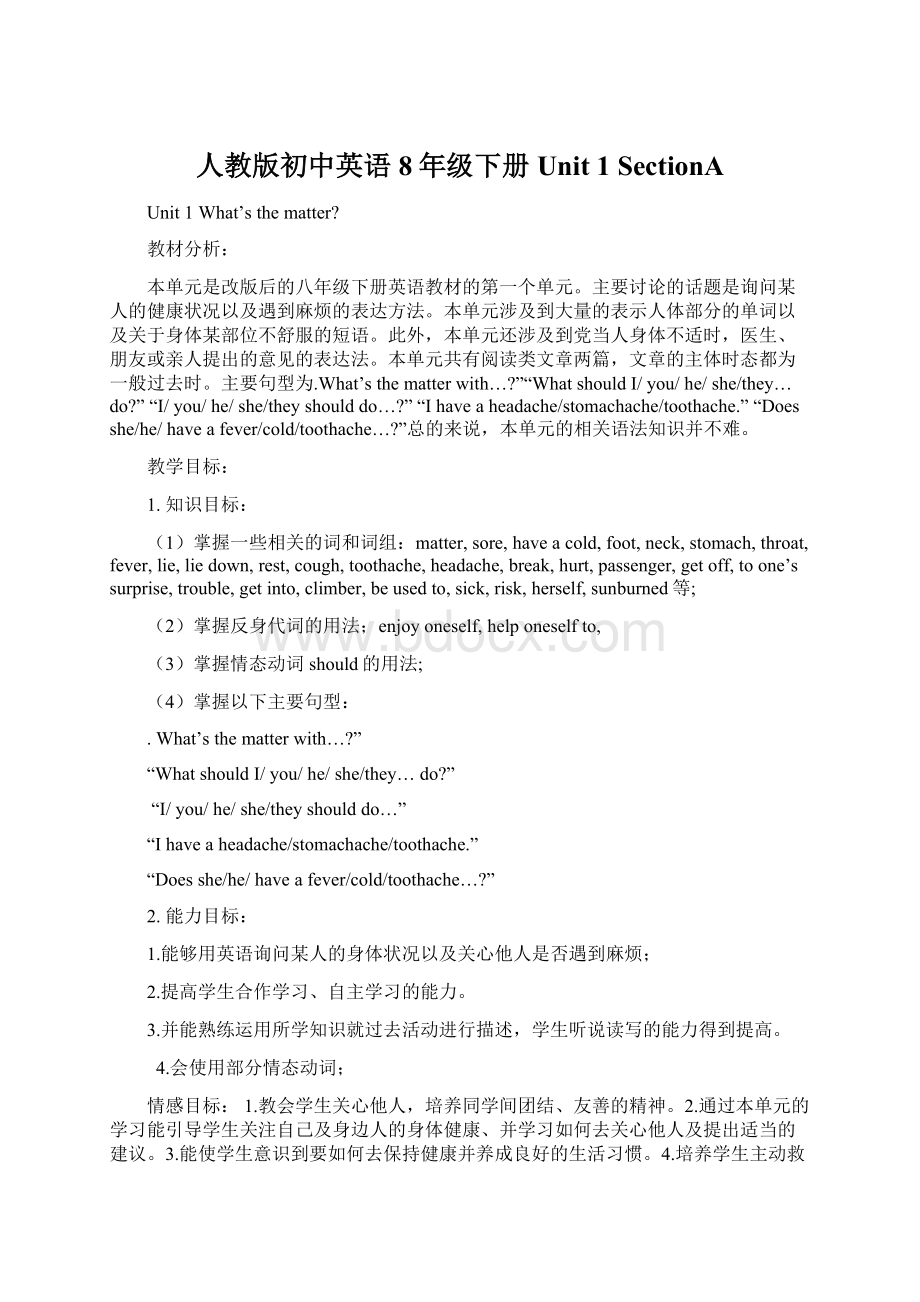人教版初中英语8年级下册 Unit 1SectionA.docx
《人教版初中英语8年级下册 Unit 1SectionA.docx》由会员分享,可在线阅读,更多相关《人教版初中英语8年级下册 Unit 1SectionA.docx(24页珍藏版)》请在冰豆网上搜索。

人教版初中英语8年级下册Unit1SectionA
Unit1What’sthematter?
教材分析:
本单元是改版后的八年级下册英语教材的第一个单元。
主要讨论的话题是询问某人的健康状况以及遇到麻烦的表达方法。
本单元涉及到大量的表示人体部分的单词以及关于身体某部位不舒服的短语。
此外,本单元还涉及到党当人身体不适时,医生、朋友或亲人提出的意见的表达法。
本单元共有阅读类文章两篇,文章的主体时态都为一般过去时。
主要句型为.What’sthematterwith…?
”“WhatshouldI/you/he/she/they…do?
”“I/you/he/she/theyshoulddo…?
”“Ihaveaheadache/stomachache/toothache.”“Doesshe/he/haveafever/cold/toothache…?
”总的来说,本单元的相关语法知识并不难。
教学目标:
1.知识目标:
(1)掌握一些相关的词和词组:
matter,sore,haveacold,foot,neck,stomach,throat,fever,lie,liedown,rest,cough,toothache,headache,break,hurt,passenger,getoff,toone’ssurprise,trouble,getinto,climber,beusedto,sick,risk,herself,sunburned等;
(2)掌握反身代词的用法;enjoyoneself,helponeselfto,
(3)掌握情态动词should的用法;
(4)掌握以下主要句型:
.What’sthematterwith…?
”
“WhatshouldI/you/he/she/they…do?
”
“I/you/he/she/theyshoulddo…”
“Ihaveaheadache/stomachache/toothache.”
“Doesshe/he/haveafever/cold/toothache…?
”
2.能力目标:
1.能够用英语询问某人的身体状况以及关心他人是否遇到麻烦;
2.提高学生合作学习、自主学习的能力。
3.并能熟练运用所学知识就过去活动进行描述,学生听说读写的能力得到提高。
4.会使用部分情态动词;
情感目标:
1.教会学生关心他人,培养同学间团结、友善的精神。
2.通过本单元的学习能引导学生关注自己及身边人的身体健康、并学习如何去关心他人及提出适当的建议。
3.能使学生意识到要如何去保持健康并养成良好的生活习惯。
4.培养学生主动救助处于危险境地的人的精神,在紧急关头,有勇气做出正确的决定。
此外,生活中遇到困境,需要有坚强的意志力去面对一切。
教学难点:
掌握情态动词should \shouldn’t.的用法
学习have的用法
课时划分:
SectionA11a–2d
SectionA23a-3c
SectionA3GrammarFocus-4c
SectionB11a-2e
SectionB23a-Selfcheck
SectionA1(1a–2d)
Step1Warmingupandnewwords
1.Lookatapictureandlearnthepartsofthebody.
2.Newwordsandphrases.
Step2Presentation
1aLookatthepicture.Writethecorrectletter[a-m]foreachpartofthebody.
___arm___back___ear___eye___foot
___hand___head___leg___mouth
___neck___nose___stomach___tooth
Step3Listening
1bListenandlookatthepicture.Thennumberthenames1-5
Listentotheconversationsagainandfillintheblanks.
Conversation1
Nurse:
What’sthematter,Sarah?
Girl:
I___________.
Conversation2
Nurse:
What’sthematter,David?
Boy:
I_________________.
Conversation3
Nurse:
What’sthematter,Ben?
Boy:
I_________________.
Conversation4
Nurse:
What’sthematter,Nancy?
Girl:
I_________________.
Conversation5
Betty:
What’sthematter,Judy?
Ann:
She__________________.
Step4Speaking
1cLookatthepictures.Whatarethestudents’problems?
Makeconversations.
Examples
A:
What’sthematterwithJudy?
B:
Shetalkedtoomuchyesterdayanddidn’tdrinkenoughwater.
Shehasaverysorethroatnow.
A:
What’sthematterwithSarah?
B:
Shedidn’ttakecareofherselfontheweekend.Shewasplayingwithherfriendsattheparkyesterday.Thenitgotwindy,butshedidn’tputonherjacket.Nowshehasacold.
Step5Guessinggames
Guesswhathashappenedtothestudentsbyusingtheimportantsentences.
Step6Listening
2aListenandnumberthepictures[1-5]intheorderyouhearthem.
2bListenagain.Matchtheproblemswiththeadvice.
Step7Speaking
2cMakeconversationsusingtheinformationin2aand2b
A:
What’sthematter?
B:
Myheadfeelsveryhot.
A:
Maybeyouhaveafever.
B:
WhatshouldIdo?
A:
Youshouldtakeyourtemperature.
Step8Role–play
Imagineyouaretheschooldoctor.Afewstudentshavehealthproblems.Role-playaconversationbetweenthedoctorandthestudents.
2dRole–playtheconversation
Step9Languagepointsandsummary
1.What’sthematter?
这是人们特别是医生和护士询问病人病情时最常用的问句,意思是“怎么了?
”其后通常与介词with连用。
类似的问句还有:
What’swrong?
怎么啦?
What’swrongwithyou?
你怎么了?
What’syourtrouble?
你怎么了?
What’sthetroublewithyou?
你怎么了?
What’sup?
你怎么了?
2.haveacold伤风,感冒,是固定词组
表示身体不适的常用词组还有:
haveabadcold重感冒
haveafever发烧
haveaheadache头痛
haveastomachache肚子痛,胃痛
haveatoothache牙痛
Summary
1.牙疼haveatoothache
2.胃疼haveastomachache
3.背疼haveabackache
4.头疼haveaheadache
5.喉咙疼haveasorethroat
6.发烧haveafever
7.感冒haveacold
8.躺下并且休息liedownandrest
9.喝热蜂蜜茶drinkhotteawithhoney
10.喝大量水drinklotsofwater
11.看牙医seeadentist
12.量体温takeone’stemperature
13.看医生gotoadoctor
Step10Exercises
根据上下文意思填空。
Mandy:
Lisa,areyouOK?
Lisa:
I_____aheadacheandIcan’tmovemyneck.What______Ido?
ShouldI
_____mytemperature?
Mandy:
No,itdoesn’tsoundlikeyouhaveafever.What_____youdoonthe
weekend?
Lisa:
Iplayedcomputer_____allweekend.
Mandy:
That’sprobablywhy.Youneedtotakebreaks_____fromthecomputer.
Lisa:
Yeah,IthinkIsatinthe_____wayfortoolongwithoutmoving.
Mandy:
Ithinkyoushould____downandrest.Ifyourheadandneckstillhurttomorrow,thengotoa_______.
Lisa:
OK.Thanks,Mandy.
翻译下列句子。
1.你怎么了?
我头痛。
2.他怎么了?
他发烧
3.李雷怎么了?
他喉咙痛。
他应该多喝水。
4.如果你的头和脖子明天仍然疼的话,请去看医生。
Homework
Makeupaconversationbetweenadoctorandapatient.
SectionA2(3a–3c)
Step1Presentation
Lookatthepicture.Discusswhathappenedandthenwhatweshoulddo.
Teacher:
Whathappenedinthepicture.
Students:
Teacher:
Whatshouldwedotohelpthem?
Students:
Teacher:
Didthebusdriverhelpthem?
Students:
Step2Reading
3aReadthepassageandanswerthefollowingquestions.
Doyouthinkitcomesfromanewspaperorabook?
Howdoyouknow?
Didthebusdriverhelpthemanandthewoman?
3bReadthepassageagainandcheckthethingsthathappenedinthestory.
1____WangPingwasthedriverofbusNo.26at9:
00a.m.yesterday.
2____BusNo.26hitanoldmanonZhonghuaRoad.
3____Theoldmanhadaheartproblemandneededtogotothehospital
rightaway.
4____Thepassagersonthebusdidnotwanttogotothehospital,soonly
WangPingwentwiththewomanandoldman.
5____Somepassagershelpedtogettheoldmanontothebus.
6____Theoldmangottothehospitalintime.
Step3Speaking
3cDiscussthequestionswithapartner.
Step4Languagespoints
1....whenthedriversawanoldmanlyingonthesideoftheroad.
......这时司机看到一位老人正躺在路边。
观察与思考:
你能看出“看到某人正在做某事”的句型吗?
seesb.doingsth.看见某人正在做某事
e.g.WhenIpassthewindowIseehimdrawingapicture.
seesb.dosth.看见某人做过某事
e.g.Ioftenseehimdrawapicture.
活学活用
1)我看见他时他正在河边玩。
Isawhim_______bytheriver.
2)我看见过他在河边玩。
Isawhim_____bytheriver.
3)我看着他过了桥。
Iseehim______acrossthebridge.
4)我看见她正在洗碗。
Iseeher_________thedishes.
2.Thebusdriver,24-year-oldWangPing,stoppedthebuswithoutthinkingtwice.
3.Heonlythoughtaboutsavingalife.
观察与思考:
你能看出“withoutthinking”、“aboutsavingalife”的共同点吗?
共同点:
介词+doing
介词+名词
宾格代词
doing
活学活用
用适当的形式填空。
1)Iamfine.Whatabout____(she)?
2)Thanksfor______(tell)methestory?
3)Itisasunnyday.Howabout_____(go)fishing?
4)Itisgoodtorelaxby______(use)theInternetor_________(watch)gameshows.
4.Buttohissurprise,theyallagreedtogowithhim.
toone’ssurprise
使......惊讶的是,出乎......意料
e.g.Totheirsurprise,allthestudentspasstheexam.
Muchtoeveryone’ssurprise,theplansucceeded.
5....becausetheydon’twantanytrouble,...
当trouble意为“困难;麻烦”时,是不可数名词。
如:
I’msorrytogiveyousomuchtrouble.
(1)beintrouble意为“有困难;陷入困境”。
如:
Healwaysasksmeforhelpwhenheisintrouble.
(2)getsb.intotrouble意为“使某人陷入困境”。
如:
Ifyoucome,youmaygetmeintotrouble.
(3)主语+have/hastrouble(in)doingsth.意为“某人在做某事方面有困难”。
如:
Ihavesometrouble(in)readingtheletter.
当trouble意为“麻烦事;烦心事”时,是可数名词。
如:
Shewasonthephoneforanhourtellingmehertroubles.
【运用】根据汉语意思完成英语句子,每空词数不限。
(1)他认为每天吃饭是一件麻烦事。
Hethinksthateatingeverydayis_________.
(2)你知道你现在为什么处于困境吗?
Doyouknowwhyyou_____________now?
(3)我妹妹在学习英语方面有困难。
Mysister_____________________English.
6.rightaway意为“立刻;马上”,和inaminute意思相近。
例如:
I’llbethererightaway/inaminute.
另外,rightnow和atonce也可表示“立刻;马上”的意思。
【运用】根据汉语意思完成英语句子,每空词数不限。
你必须马上出发。
Youmuststart_________________________________________.
重点短语
1)看到某人正在做某事
2)让某人吃惊的是
3)下车
4)上车
5)多亏,幸亏
6)考虑
7)同意做某事
8)造成麻烦
seesb.doingsth.
toone’ssurprise
getoffthebus
getonthebus
thanksto
thinkabout
agreetodosth.
getintotrouble
Step5Exercises
用括号内的词的适当形式填空。
1.Thedriversawanoldman_____(lie)ontheroad.
2.Isatinthesamewaywithout________(move).
3.Heonlythoughtabout______(save)alifeanddidn’tthinkabout_______(him).
4.Theoldmanneeded_____(go)tothehospital.
5.Awomanwas________(shout)forhelp.
6.Heexpectedthem______(get)offthebus.
SectionA3(Grammarfocus–4c)
Step1Revision(Guessinggame)
Lookatthepictures,guesswhathashappenedandrevisetheimportantpointsthestudentshavelearned.
Step2Grammarfocus
What’sthematter?
Ihaveastomachache.
Youshouldn’teatsomuchnexttime.
What’sthematterwithBen?
Hehurthimself.Hehasasoreback.
Heshouldliedownandrest.
Doyouhaveafever?
Yes,Ido./No,Idon’t./Idon’tknow.
Doeshehaveatoothache?
Yes,hedoes.
HeshouldseeadentistandgetanX-ray.
Whatshouldshedo?
Sheshouldtakehertemperature.
ShouldIputsomemedicineonit?
Yes,youshould./No,youshouldn’t.
观察与思考
读以下四个句子,总结出have的用法。
have\has
Ihaveabag.
Hehasnoodlesforbreakfast.
Ihaveabadcold.
Theyhavealookatthepicture.
用法展现
1.作“有”讲。
如:
Ihaveabag.我有一个包。
Hehasaredcup.他有一个红杯子。
2.作“吃、喝”讲。
如:
havebreakfast(吃早饭)
havetea(喝茶)
haveabiscuit(吃块饼干)
haveadrink(喝点水)
3.作“患病”讲。
haveacold,haveafever
4.固定短语
haveatry,havealook,haveaparty
活学活用
1.她有许多好朋友。
She____lotsofgoodfriends.
2.当我们感冒时,应该多喝水。
Whenwe_____badcolds,weshoulddrinkmorewater.
3.他早餐常吃鸡蛋。
He____eggsforbreakfast.
4.他昨天去参加聚会了。
He___________ye